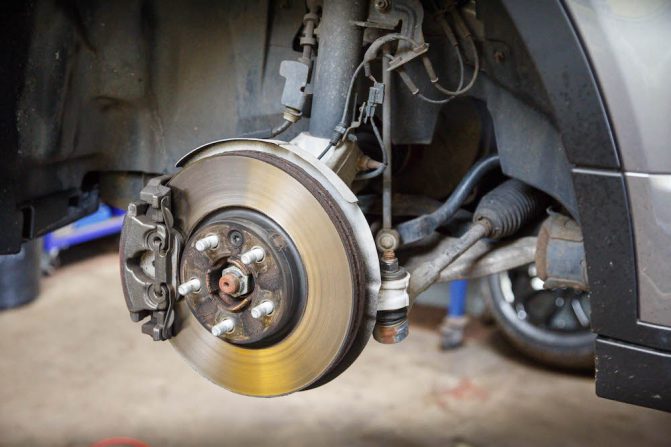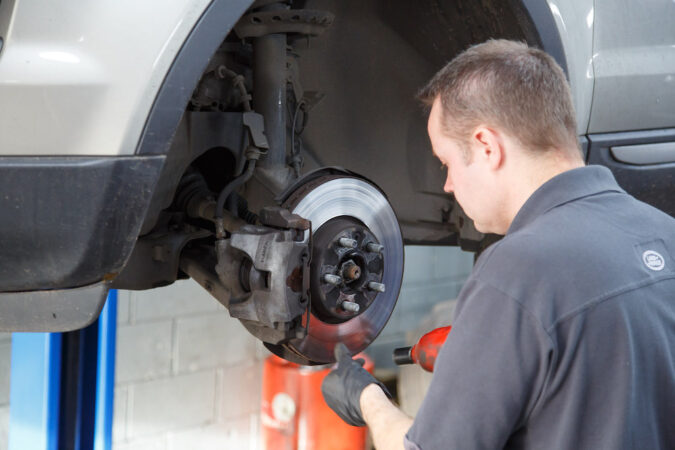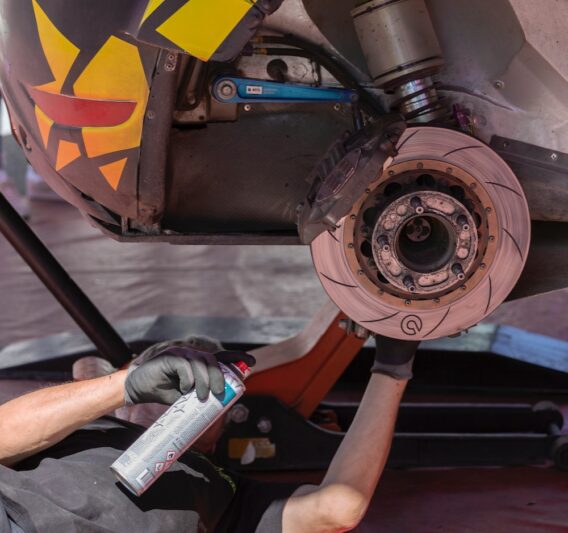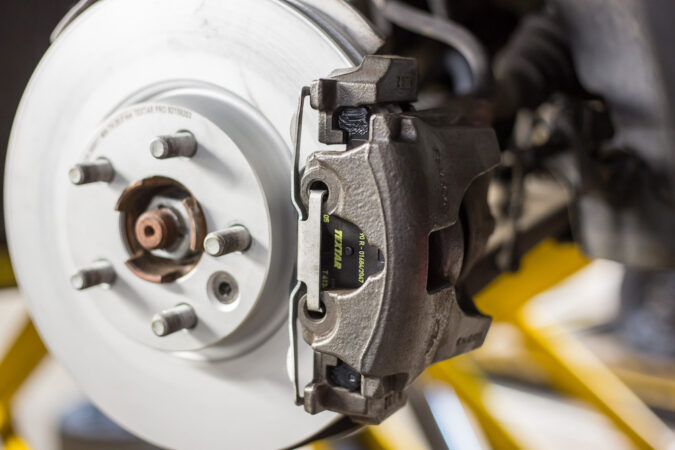Your car’s brakes, as small as they seem to be, are very powerful machines by themselves. Think about it… Those brakes need to, at an instant, create enough friction to slow down and stop your car. Within which contains thousands of pounds worth of metals, plastics, rubber, glass, fuel, oil, fluids, as well as the meaty human flesh that’s driving it. It’s for all this power and the immense strain that every once in a while, you need to worry about things like brake calipers replacement cost.
After all, few things are as deadly as putting yourself behind the wheel of a car that can’t, and won’t slow down as the brakes stop working. At the very least, poorly brake calipers aren’t able to stop you just as promptly, or even force your car to swerve from side to side. It goes to show at proving how crucial it is to pay close attention to how your car’s brakes are doing, even if they do work well 99.99% of the time. So, how much are brake calipers replacement cost for your car?
- What Are Brake Calipers?
- When To Replace?
- Causes For Replacement
- Types Of Calipers
- Symptoms
- Fixes And Costs
- Conclusion
Brake Caliper
Spoiler alert, brake calipers replacement cost isn’t going to be cheap, despite it being an important fix to do. Nonetheless, let’s move that aside for now, and try to wrap our heads around what they are, and how brake calipers work.
Within the entire braking system on your car, more specifically that fitted around the wheels, there are a few key components. When it comes to slowing down and stopping your car, you have brake pads.
Then, you have the brake discs, or rotors, as they’re sometimes called. Friction is caused when the brake pads start rubbing against the discs. There are two sets of brake pads, each on either side of the disc (or rotor) plate.
Their friction pads in particular are faced toward the discs. Either through hydraulic pressure or an electrical brake-by-wire system, your input on the brake pedal will then clamp together the brake pads against the disc.
This intense frictional force converts your car’s kinetic energy into thermal energy, thus slowing down the movement of the wheels. But the brake pads can’t press down on the discs on their own.
This is where the brake calipers come in. When you look at a car’s brakes, you can see the plate-shaped disc quite plainly. Then, you may see a somewhat crescent-shaped contraption strapped along to the side of the brake discs.
This here is the brake caliper, which functions to clamp the brake pads down against the rotors. When you press down on the brake pedal, the calipers’ pistons become pressurized. This can then squeeze the brake pads onto the rotors with all its might.
How Long Do Brake Calipers Last
If they’re so important, why then must you need to worry about brake calipers replacement cost in the first place? As much as it tries to keep your person and passengers safe, brake calipers undergo a lot of strain and stress in their daily workload.
We’ll discuss more on what’s causing them to wear out and necessitate a replacement in the next section. For now, though, there’s some good news to think over. Although you’ll need to replace them eventually, it won’t need to be done often.
Brake calipers are designed and made to last for a long time, even if that timeframe is unfortunately not forever. In fact, they’re expected to last as long as the average lifespan of most cars.
Generally, the real-world lifecycle of brake calipers is anywhere between 75,000 miles, or upwards of over 100,000 miles. In other words, around 10 years of average use with most cars. Mind you, this is a very broad and rough estimate and doesn’t take into consideration of several key variables.
What Causes Brake Calipers To Fail
And just what are those variables that get you up at night thinking over brake calipers replacement cost? Certain factors do play a key role. One example is the way that you drive your car, and how calmly or egregiously you are with the brake pedal.
There’s also the smooth- or harshness of the road that you’ll be driving on, and the environment that those poor brakes are exposed to. Even the humidity in the air can determine how badly your brake calipers will age and wear.
Nevertheless, there is a common denominator that wears down your brake calipers. As we’ve thus far established, your brakes are surrounded by a lot of heat. Not only the pads and discs, but the calipers themselves will see their temperature rise to over 300℉, even under normal braking forces.
But as you lift your foot off the brake pedal, the calipers are then rapidly cooled by the surrounding air. These repeated ‘heat-up’ and ‘cool-down’ cycles appear every time you brake, thousands of times.
Rusty Calipers
As this perpetuates, corrosion can form inside and outside of the brake calipers. This oxidation can be caused by moisture in the air or water that’s been kicked up and absorbed from the road.
In any event, the water will then boil and turns into steam. This is a result of the aforementioned heat-up and cool-down cycles. Multiply that by the endless times that your brake – over years worth of driving – will boil, condense, and re-boil that water again, and again. This is how corrosion starts forming.
The corrosion will start to form a rough surface along the calipers’ pistons or cylinder walls. The result is this highly abrasive wear on the brake piston seals, as it has to slide in and out through all that rust.
From your point of view, it may cause uneven braking performance. Yet, the rust can still get worse once it eats its way into the inner walls. The whole system may seize up and stop moving – or clamping – entirely, as the pistons become stuck behind thick rust in their cylinder chambers.
Brake Calipers Types
Since you’ll be thinking about brake calipers replacement costs, it should be helpful to know about all the different types of calipers out there. Didn’t think there are varying designs in brake calipers, did you? Thankfully, it’s not as confusing as some other automotive componentry.
There are only so many ways that you can make a car stop. Regardless, all brake calipers have the same concept in function, which is to clamp down the brake pads on the brake discs, thus creating friction.
How they do that, is a whole other matter. There’s not just the type, but also the number of pistons each caliper has. Generally, the higher the piston count, the better the braking performance would be. For our little guide, here are a couple of examples of the types of brake calipers that you can get for your car…
1. Floating Calipers
Floating caliper designs are commonly found in most road cars today. They have a piston – or pistons – only on one side of the rotor. Using a set of bushings and pins, the floating caliper thus slides back and forth to clamp down on the rotor.
So, when you press down on the brake pedal, the piston clamps the brake pads only for the inboard (inner) side of the rotor. The caliper will then slide on the bushings and pins until it can squeeze the outboard (outer) pad against the rotor.
2. Fixed Calipers
Fixed calipers are usually found in higher-performance vehicles, thanks to their added complexity and promise of greater braking force. They can have anywhere from 2 to 8 or more pistons each. As the name suggests, it doesn’t have any bushings or pins to slide it around.
Mounted in place, a fixed caliper will have an equal number of pistons on both the inboard and outboard sections of the caliper. With pistons on both sides, the calipers will then clamp both halves down onto the discs.
Bad Caliper Symptoms
With all this friction, heat, and corrosion in mind, it’s quite surprising that brake calipers can survive as long as they do. It may vary widely depending on your vehicle of choice and how you use it.
However, you should comfortably know that brake caliper replacement costs won’t have to occur too often. Nonetheless, they do need replacing. If you’ve forgotten your regular servicing interval, are there any ways that you can notice when it’s time to have fresh calipers installed?
Indeed, there are some ways that you can spot when your brake calipers are on their way out. Here are some examples of tell-tale symptoms that you should have your car sent over to a workshop right away…
Calipers Replacement Cost, Symptoms #1: Unusual Noises While Under Braking
Your car’s brakes might squeal a little bit when they’re cold, but they shouldn’t be all that loud. If you ever hear a piercing screech, squeal, or grinding sound when pressing the brake pedal, then there’s definitely a problem that abounds. Oftentimes, this is indicative of your brake pads that have been worn down to the bare metal backplate.
Sometimes, though, they can point out faults of a failing brake caliper. It could be the calipers being stuck in place, as the pistons were jammed within the brake cylinders. As we noted earlier, this is caused usually by extensive corrosion. When this happens, your brakes will either stop working altogether, or they might still give out some meager braking performance.
Calipers Replacement Cost, Symptoms #2: Uneven Brake Pad Wear
We’ve learned so far that the brake pads are what contacts the brake discs (or rotors) to engage in frictional force to slow down your car. When everything is working fine, all your car’s brake pads on all sides of the vehicle – measured commonly by front- and rear-axles, respectively – should wear out at the same rate. This is because the braking force is made to be distributed evenly.
That said, defective brake calipers can be faulted when there’s uneven brake pad wear. If the brake calipers are corrosive or damaged, then the pistons can’t clamp the pads down as smoothly or freely as it’s supposed to. Consequently, it will exert a non-uniform braking pressure. This leads to one side, axle, or a quarter of the car wearing out its brake pads faster or slower than the others.
Calipers Replacement Cost, Symptoms #3: Car Pulling To One Side When Braking
Another dangerous symptom of poorly brake calipers can be felt through the way your car handles under braking. With good brakes, a car should remain centered, even under heavy braking.
However, bad calipers can test this, with your car sometimes veering or pulling to one side when you press the brake pedal. This left or right swaying can be subtle, or sometimes horrifyingly hazardous.
This can happen, once again, thanks to corrosion or damage along the brake calipers. For example, heavy rusting causes the pistons to get stuck inside the brake cylinders. Now when you press down on the brake pedal, the car will swerve towards the side with the best braking performance. If you stop braking, the car will veer back to the side with the faulty or stuck brake calipers.
Calipers Replacement Cost, Symptoms #4: Brake Fluids Leaking
Within your brakes, there are brake fluids. These are hydraulic liquids, which pressurize the pistons to move the calipers in and out at the command of the brake pedals. Back to the matter of rust, this heavily abrasive corrosion can rub against, and wear out the seals on your brake caliper pistons. When this happens, the brake fluids contained in them will likely start leaking out.
As soon as it starts leaking, the hydraulic pressure will be affected. The lesser the volume of brake fluids that you have, the more pressure that’s required to work the pistons.
If the leaks have become far too serious, and your brake fluids fall in quantity by too much, the brakes won’t stop you as well as they did before. Worse, the entire braking system might fail to work entirely.
Calipers Replacement Cost, Symptoms #5: Soft And Spongy Brake Pedal
An extension of the previous point that we made, you can feel a lot of how the brakes are based on the way the pedal feels. If the brake calipers – or other components within the braking system – are defective, or just about to be, you can feel the brake pedals feeling soft or spongy when you step on them. Often, this is attributed to a brake fluid leak, when the hydraulic pressure starts to drop.
As the pistons seize up, there is a lot of empty space between the brake pads and the brake discs. Therefore, you’ll need to press the brake pedal a lot further down and harder just to make the brakes work.
On top of that, you might even have to pump up the brakes, by pressing it down, lifting your feet up, and pressing it back down repeatedly.
Calipers Replacement Cost, Symptoms #6: Poor (Or Too Much) Braking Performance
Perhaps the most obvious tell-tale sign that your brake calipers – or brakes as a whole – are in need of a check-up is when the braking performance falls off a cliff. You can notice that your car takes both longer, and covers a greater distance in order to slow down and come to a halt. You may have to use all the available brake pedal depression to have it stop at all.
As usual, we attribute this to corrosion. When there’s too much rust build-up in the inner cylinder walls, the piston can get stuck. Hence, the brake calipers can’t clamp down on the brakes at all.
Or, it might still clamp down, but without sufficient pressure to create enough frictional force. Naturally, you’ll find that it takes more time and distance to slow your car down.
On the flip side, there are cases when the car itself is feeling sluggish when not under braking. This happens when instead of the pistons being stuck and seizing up inside the cylinder, they’re stuck in their fully-braked stance.
The pistons will continue to force the calipers to clamp down on the brakes when you don’t want them to. In regular driving, it feels as though you’re constantly on the brake pedal.
Caliper Replacement Cost
Let this sentence be a reminder that choosing to keep calm and carry on driving with poorly or faulty brakes is a big no-no. This is a mistake that can cost your life. As you can imagine, it’s not good to have zero control over your car.
So, despite the heavy burden of a full brake calipers replacement cost, it’s a price that’s certainly worth paying for. There are a few things to consider when tabulating the final cost of a full brake caliper replacement.
The most crucial of which is what make and model of the car you own, which ultimately decides the caliber of the brakes that it’ll need. For that reason, the average calipers replacement cost will vary anywhere from just $150, all the way up to $900.
That’s quite a huge variance in price. If you drive a more common roadgoing car, then the cost may range lower to around $200 to $500. Although, if you own a luxury, high-performance, or heavy-duty vehicle, expect the price to be $500 or higher.
An Audi, BMW, or Mercedes, for example, may cost $800 to $1,000 for a brake caliper replacement. It’s worth mentioning, as well, that those quoted prices are for each individual caliper, not an axle pair.
And once you’re already paying for a brake caliper replacement, you may want to spend it on the rotors and pads, as well. A repair and change of both the pads and rotors can average mostly around $250 to $500 per axle, accounting for labor and parts.
How Much Is A Brake Caliper
In short, a full brake repair job – including the calipers – may cost you upwards of $1,000 for most cars. Not cheap. But are there ways in which you can save on calipers replacement costs?
A common question that people ask is whether they can only replace the calipers on one side of the car. Say, only on the front-left wheel, and eschewing any changes on the front-right. Our answer to this is that it’s inadvisable to replace only one side of the brake calipers.
That’s assuming that both sides of the calipers are even of the same brand, type, and specification. If you replace the caliper only on one side, this may distribute the braking force unevenly.
This isn’t just dangerous but could wear out both the new and old calipers prematurely. The general rule of thumb here is to replace an entire axle’s worth of calipers at a time, either front or rear. You may be forgiven to replace the caliper on one side if the other caliper is mostly new and relatively unused.
How To Rebuild Caliper
Another common cost-cutting conundrum is the argument to rebuild old brake calipers instead of replacing them outright. In other words, an old caliper can be stripped down, and have its individual parts rebuilt and replaced.
For example, these can be pistons, seals, bushings, guide pins, pin sleeves, covers, boots, and so on. Although your brake calipers might be wearing out, they could be fixed simply by replacing any one or a combination of these constituent units rather than the whole thing.
It can indeed save on material costs and raw parts. However, you’ll need to worry about labor. Given how complex the brake calipers are, it will take a skilled technician many hours to diagnose, and then replace each tiny part.
This is compared to the relatively simple job of putting on the entire caliper. It does make economical sense if you’re willing to save on labor costs and do this yourself. Still, it takes quite a lot of skill and effort, though there’s no shortage of guides online to help you.
Calipers Replacement Cost: In Conclusion…
Now rounding off our guide on brake calipers replacement cost, it definitely hasn’t been easy on the heart, has it? Compared to most other automotive repairs, brake calipers – at a cost of at least $300 or so on average for most cars apiece – are quite expensive.
But the benefits of having new calipers are profound, both affecting the performance of your car and safety. Plus, brake calipers are made to last for a long time. It seems then, that this is one lofty price tag that is worth paying for.
FAQs On Calipers Replacement Cost
If you’re still curious to learn more about calipers replacement costs, our FAQs here might help…
How To Unstick A Brake Caliper
If your brake calipers are exposed to too much corrosion, this can cause the caliper’s pistons or slide pins to become stuck. As these are the ones who are responsible for the calipers clamping down on the brake pads, faulty pistons or slide pins can cause the calipers to stick. There are a few ways to unstick them, though. A professional mechanic may have some special tools to dislodge and force the stuck calipers open. If not, a simple c-clamp should do the trick, too. Otherwise, you could also try using the brakes’ hydraulic pressure to unstick them. First, you’ll have to remove the brake calipers (but without detaching them fully). Then, pump on the brake pedal until the pistons are able to move past the corroded area and become unstuck.
How To Tell If Brake Caliper Is Bad
If your brake calipers aren’t working properly, there are a few ways to tell. Usually, you’d notice the symptoms of a faulty brake caliper while under braking. For instance, you might hear odd squealing or grinding while you’re braking. Other than that, you’ll surely feel the car pulling and veering to one side or the other, in addition to weird vibrations. The brake pads would also wear unevenly when being clamped down by malfunctioning calipers, as well. A spongy brake pedal is another good way to tell if your car’s brake calipers aren’t working right. Brake fluids leaking and poor braking performance are two other symptoms that will appear if your car needs a full brake caliper check-up and replacement.
How To Remove A Brake Caliper
Once you’ve jacked up your car, secured it on some axle stands, and removed the tires… You can begin to detach the brake calipers. You can start by removing the bolts situated on the back of the calipers, which hold them onto the brake rotors/discs. Once that’s done, you can use a screwdriver to pry the brake caliper off the brake pads. After that, you may remove the brake pads and then disassemble the brake caliper bracket. If you’re removing it fully, you’ll then have to disconnect the brake lines, too. To put some new brake calipers onto your car, simply repeat the aforementioned steps backward. Finally, you can bleed the old brake fluids out and replace them with a new bottle. Be sure to test out the braking performance to ensure that you’ve done it all right.
How Much Is A Caliper
The cost of replacing brake calipers varies wildly depending on what car you’re fitting it to. For regular, road-going vehicles, a single brake caliper averages between $150 to $500. However, you should expect to pay much more than this if you drive a luxury, high-performance, or heavy-duty vehicle. For instance, a luxury car such as an Audi, BMW, or Mercedes might set you back between $800 to $1,000 (or even more) for a brake caliper replacement. That’s not all, either. Once you’ve replaced the brake calipers, it’s a good idea to swap out the brake rotors and brake pads, too. Between those two, it might cost you as much as $250 to $500 per axle (for two wheels). You can expect it to go even higher if you’re using specialty brakes for sports cars or off-roaders.
How Hot Do Brake Calipers Get
A car’s brakes are designed to create friction in a bid to slow down and stop a vehicle by scrubbing away all its momentum and inertia. For that reason, brakes tend to get pretty hot, including the brake calipers. If you’re driving hard, such as constantly using the brakes at a race track, the calipers could heat up to 500 degrees Fahrenheit. Or, about 250 degrees Celsius. This is considered very hot for brake calipers. On the other hand, brake calipers won’t usually go beyond 250 degrees Fahrenheit when you’re just driving around normally. As it reaches into the 300+ and 400+ degrees Fahrenheit mark, your brake calipers are getting toasty, and good ventilation is a must to cool them down. Anything above 500+ degrees Celsius would require a check-up afterward for any damage.




